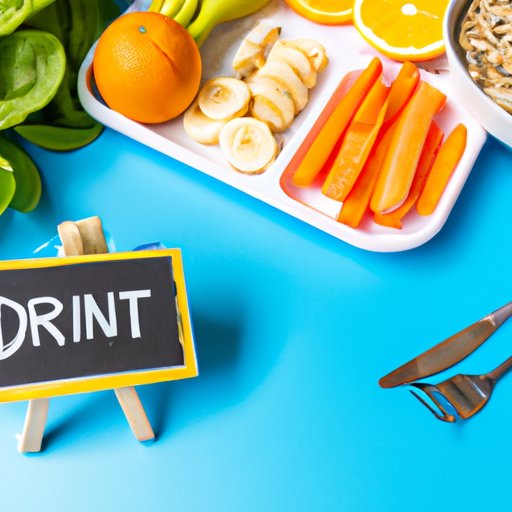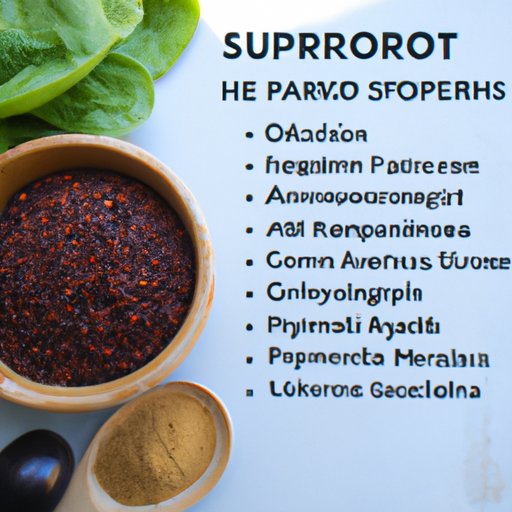Introduction
The term “diet” has become synonymous with restrictive eating and deprivation. However, a diet doesn’t have to mean depriving yourself of the foods you love and counting calories all day. Eating a healthy, balanced diet is key to maintaining a healthy lifestyle and achieving your goals. This article will provide an in-depth look into what foods you should include when dieting, how to craft a meal plan, and the benefits of superfoods.
Healthy Eating on a Diet: A Guide to What Foods You Should Include
When it comes to dieting, there is no one-size-fits-all approach. The best way to ensure you are getting the nutrition your body needs is to focus on eating a variety of healthy, nutrient-dense foods. Some of the best foods to include in your diet are:
Fruits and vegetables
Fruits and vegetables are packed with vitamins, minerals, antioxidants, and fiber. They are low in calories and can help fill you up without adding extra fat or sugar to your diet. Aim to consume a variety of colors each day for maximum nutritional benefit.
Whole grains
Whole grains are a great source of energy and fiber. They can help keep you feeling full while providing essential vitamins and minerals. Choose whole grain options such as brown rice, quinoa, oats, and barley over refined grains like white flour and white rice.
Lean proteins
Protein is an important part of any diet. Lean proteins such as chicken, fish, eggs, and tofu are low in fat and high in essential nutrients. These can help keep you feeling full and provide your body with the fuel it needs to stay energized throughout the day.
Low-fat dairy products
Low-fat dairy products are a great source of calcium, protein, and other essential vitamins and minerals. Look for low-fat versions of milk, yogurt, and cheese to get the most nutritional benefit without adding extra fat and calories to your diet.
Healthy fats
Healthy fats are an important part of any diet. They help keep you feeling full and provide essential vitamins and minerals. Healthy fats such as avocados, nuts, and seeds are rich in monounsaturated and polyunsaturated fatty acids. These can be added to meals or snacks to boost nutrition and flavor.
Exploring Low-Calorie Food Options for Dieters
When trying to lose weight, it’s important to focus on eating low-calorie foods that are still nutritious. Here are some great low-calorie food options for dieters:
Vegetables
Vegetables are low in calories and packed with essential vitamins and minerals. Try incorporating a variety of different vegetables into your meals and snacks. Roast them, steam them, or add them to salads for a nutritious and filling option.
Fruits
Fruits are a great low-calorie snack option. Apples, oranges, and berries are all packed with vitamins and minerals and can help satisfy your sweet tooth without packing on the pounds. Try adding fresh or frozen fruit to smoothies or oatmeal for a delicious and nutritious treat.
Nuts and seeds
Nuts and seeds are a great source of healthy fats and protein. They are also low in calories and can help keep you feeling full. Choose unsalted, raw, or dry-roasted varieties for the most nutritional benefit.
Legumes
Legumes such as beans and lentils are a great source of protein and fiber. They are also low in calories and can help keep you feeling full for longer. Try adding them to salads, soups, or casseroles for a nutritious and filling meal.
Lean proteins
Lean proteins such as chicken, fish, and eggs are low in calories and high in essential nutrients. They can help keep you feeling full and provide your body with the fuel it needs to stay energized throughout the day.

Crafting a Meal Plan on a Diet: Tips and Tricks
Creating a meal plan can be a great way to ensure you’re getting the nutrients your body needs while staying within your calorie limit. Here are some tips and tricks to help you create a successful meal plan:
Planning ahead
Planning ahead is key to success when it comes to dieting. Take time to plan out your meals and snacks for the week so you know exactly what you’ll be eating and when. This can help you stay on track and avoid unhealthy impulse decisions.
Making meals in bulk
Making meals in bulk can save you time and money. Try making large batches of soup, chili, or stew that you can freeze and enjoy throughout the week. This can help you stay on track and make sure you’re eating a variety of nutrient-dense foods.
Utilizing leftovers
Leftovers can be a lifesaver when it comes to dieting. Make sure to save any extra food from dinner or lunch to use as a quick and easy meal later in the week. This can help you save time and money while still getting the nutrition your body needs.
Tracking your progress
Tracking your progress can be a great way to stay motivated and on track with your diet. Keep a record of what you’ve eaten, how much you’ve exercised, and how you’re feeling. This can help you identify areas where you need to make changes and celebrate successes.

The Best Foods to Eat While Dieting
When it comes to dieting, it’s important to focus on eating nutrient-dense foods. Here are some of the best foods to eat while dieting:
Leafy greens
Leafy greens such as spinach, kale, and collard greens are packed with vitamins and minerals. They are low in calories and can help fill you up without adding extra fat or sugar to your diet.
Beans and legumes
Beans and legumes are a great source of protein and fiber. They are low in calories and can help keep you feeling full for longer. Try adding them to salads, soups, or casseroles for a nutritious and filling meal.
Fruits
Fruits are a great source of vitamins and minerals. They are low in calories and can help satisfy your sweet tooth without packing on the pounds. Try adding fresh or frozen fruit to smoothies or oatmeal for a delicious and nutritious treat.
Nuts
Nuts are a great source of healthy fats and protein. They are also low in calories and can help keep you feeling full. Choose unsalted, raw, or dry-roasted varieties for the most nutritional benefit.
Whole grains
Whole grains are a great source of energy and fiber. They can help keep you feeling full while providing essential vitamins and minerals. Choose whole grain options such as brown rice, quinoa, oats, and barley over refined grains like white flour and white rice.
Lean proteins
Lean proteins such as chicken, fish, eggs, and tofu are low in fat and high in essential nutrients. These can help keep you feeling full and provide your body with the fuel it needs to stay energized throughout the day.
Substituting High-Calorie Foods with Healthier Alternatives
When trying to lose weight, it’s important to focus on eating healthier alternatives to high-calorie foods. Here are some ways to do this:
Replacing unhealthy fats with healthy fats
Unhealthy fats such as saturated and trans fats can increase your risk of heart disease and weight gain. Try replacing them with healthy fats such as olive oil, avocado, and nuts. These can help keep you feeling full and provide essential vitamins and minerals.
Swapping processed foods with whole foods
Processed foods are often high in calories, sugar, and unhealthy fats. Try swapping them out with whole foods such as fruits, vegetables, lean proteins, and whole grains. These can help keep you feeling full while providing essential vitamins and minerals.
Cutting back on added sugars
Added sugars can be found in many processed foods and can lead to weight gain. Try cutting back on added sugars by limiting your intake of candy, soda, and baked goods. Instead, opt for natural sources of sugar such as fruits for a healthier alternative.
Cooking Light: Low-Calorie Recipes for Dieters
Cooking light is a great way to make sure you’re getting the nutrition your body needs without going overboard on calories. Here are some recipes to try:
Salads
Salads are a great way to get your daily dose of vegetables. Try adding lean proteins such as chicken or fish and healthy fats such as nuts or avocado for a delicious and nutritious meal. Add a light vinaigrette for flavor and you’ve got a healthy and satisfying meal.
Soups
Soups are a great way to get in a variety of veggies and lean proteins. Try adding beans, lentils, and lean meats such as chicken or fish for a filling and nutritious meal. Top with herbs and spices for extra flavor and you’ve got a delicious and healthy meal.
Stir-fries
Stir-fries are a great way to get in a variety of vegetables and lean proteins. Try adding a variety of colorful vegetables such as bell peppers, carrots, and broccoli. Add lean proteins such as tofu or chicken and top with a light sauce for flavor. Serve over brown rice or quinoa for a complete meal.
Grilled dishes
Grilled dishes are a great way to get in lean proteins and healthy fats. Try grilling lean meats such as chicken or fish and topping with herbs and spices for extra flavor. Serve with a side of grilled vegetables and a light dressing for a delicious and nutritious meal.
Baked goods
Baked goods don’t have to be off limits when dieting. Try baking with whole wheat flour and substituting sugar with applesauce or honey for a healthier version. Add in nuts and seeds for extra protein and fiber and you’ve got a delicious and nutritious treat.

Exploring the Benefits of Superfoods for Dieters
Superfoods are foods that are packed with essential nutrients and can help support a healthy diet. Here are some of the benefits of superfoods for dieters:
Antioxidants
Antioxidants are compounds that can help protect your cells from damage. Superfoods such as blueberries, dark chocolate, and green tea are packed with antioxidants that can help reduce inflammation and protect against disease.
Fiber
Fiber is an important part of any diet. Superfoods such as chia seeds, flaxseeds, and oats are great sources of fiber that can help keep you feeling full and provide essential vitamins and minerals.
Omega-3 fatty acids
Omega-3 fatty acids are essential fatty acids that can help reduce inflammation and improve heart health. Superfoods such as salmon, walnuts, and flaxseeds are great sources of omega-3 fatty acids.
Vitamins and minerals
Vitamins and minerals are essential for proper functioning of the body. Superfoods such as kale, spinach, and spirulina are packed with essential vitamins and minerals that can help keep you feeling energized and healthy.
Conclusion
Dieting doesn’t have to mean deprivation and counting calories all day. Eating a healthy, balanced diet is key to maintaining a healthy lifestyle and achieving your goals. This article has provided an in-depth look into what foods you should include when dieting, how to craft a meal plan, and the benefits of superfoods. Remember to focus on eating a variety of nutrient-dense foods, planning ahead, and tracking your progress. With these tips, you will be able to create a successful and sustainable diet plan.
(Note: Is this article not meeting your expectations? Do you have knowledge or insights to share? Unlock new opportunities and expand your reach by joining our authors team. Click Registration to join us and share your expertise with our readers.)
